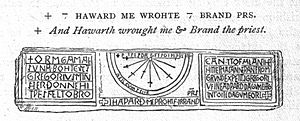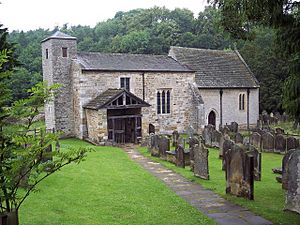Kirkdale sundial facts for kids

The Saxon sundial at St Gregory's Minster, Kirkdale in North Yorkshire is a very old sundial. It was made around the mid-11th century. This special sundial is called a canonical sundial because it helped people tell time for church services.
The sundial is carved into a stone panel above the church doors. On either side of it are other stone panels with a rare message written in Old English. This was the language spoken by the Anglo-Saxons. The sundial was found again in 1771 during some repairs. It tells us about the church being rebuilt around the year 1055. A man named Orm, son of Gamal, rebuilt it. His name sounds Scandinavian, which suggests his family might have been Vikings. Vikings came to and settled in this area in the late 800s.
Contents
What the Inscription Says
The words carved on the sundial are very old. They are written in Old English. Here is what they say:
- Orm Gamal suna bohte Sanctus Gregorius Minster ðonne hit wæs æl tobrocan and tofalan and he hit let macan newan from grunde Christe and Sanctus Gregorius in Eadward dagum cyning and in Tosti dagum eorl.
This means: "Orm, son of Gamal, bought St Gregory's Minster when it was all broken down and fallen. He had it made new from the ground for Christ and St. Gregory. This happened in the days of Edward the king and in the days of Tosti the eorl."
The sundial itself has more words carved on it:
- + ÞIS IS DÆGES SOLMERCA + / ÆT ILCVM TIDE
This means: "This is the day's sun-marker, at every hour."
At the bottom of the middle panel, it says:
- +7 HAǷARÐ ME ǷROHTE 7 BRAND / PRS
This means: "And Haward made me and Brand priest(s)."
Who Was Mentioned in the Inscription?
The inscription talks about Edward the Confessor, who was the king at the time. It also mentions Earl Tostig. Tostig was King Edward's brother-in-law. He was also the brother of Harold, who later became king.
Tostig was in charge of the area called Northumbria from 1055 to 1065. This helps us know that the church was rebuilt during those years.
Experts have looked closely at the last sentence of the inscription. Some believe it means two things: Hawarth was the craftsman who made the sundial, and Brand was the priest. Others think both Hawarth and Brand the priest worked together on it. It's thought that Brand might have planned how the words would be laid out.
Why is the Sundial Important?
This sundial is very important for understanding history. It shows that even a century and a half after Vikings settled in the area, their descendants, like Orm Gamalson, were using English. They chose English instead of Danish or Norwegian for important carvings like this. This tells us a lot about how languages changed and mixed in England long ago.
Images for kids



